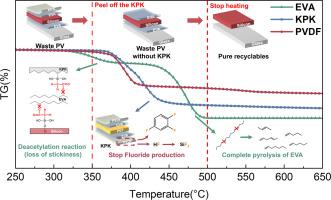A fluorine-restrained pyrolysis process for sustainable photovoltaic modules recycling: two-stage decomposition of EVA and fluorine-containing backsheets
IF 10.9
1区 环境科学与生态学
Q1 ENGINEERING, ENVIRONMENTAL
引用次数: 0
Abstract
Annually accumulating decommissioned Photovoltaic modules pose severe environmental risks. Pyrolysis is key for resource recovery via disassembly, but conventional 500 °C pyrolysis produces hazardous fluorinated pollution. This study analyzed pyrolysis mechanisms for EVA encapsulant and fluorinated KPK backsheets (PVDF/PET/PVDF) using thermal, IR, and MS techniques. Key findings: (1) EVA pyrolyzes in two stages: dominant deacetylation (300–400 °C), then chain scission (400–500 °C); (2) PVDF decomposition (300–600 °C) releases most fluorine as gaseous pollutants (e.g., 1,2,4-trifluorobenzene, SiF₄), leaving fluoride-containing solid residues; (3) The major KPK weight loss peak (350–500 °C) stems primarily from PET. Exploiting these thermal properties, a novel two-stage, fluorine-controlled process is proposed: First, heat to 350 °C to trigger intense EVA deacetylation and adhesion loss before significant PVDF cracking, allowing non-polluting backsheet removal. Then, raise temperature to 500 °C to fully pyrolyze residual EVA. This clarifies fluoride pathways and offers a practical emission-mitigation solution for thermal dismantling.

可持续光伏组件回收的限氟热解工艺:EVA和含氟背板的两阶段分解
每年累积的退役光伏组件构成严重的环境风险。热解是通过拆解回收资源的关键,但常规的500°C热解会产生有害的氟化污染。本研究利用热、红外和质谱技术分析了EVA封装剂和氟化KPK背板(PVDF/PET/PVDF)的热解机理。主要发现:(1)EVA热解分为两个阶段:先去乙酰化(300-400°C),然后是链断裂(400-500°C);(2) PVDF分解(300-600°C)释放出大部分氟作为气态污染物(例如1,2,4-三氟苯,SiF₄),留下含氟的固体残留物;(3)主要的KPK失重峰(350 ~ 500℃)主要来自PET。利用这些热特性,提出了一种新的两阶段氟控制工艺:首先,加热到350°C,在PVDF显著开裂之前触发强烈的EVA去乙酰化和附着力损失,从而实现无污染的背板去除。然后,将温度升高到500℃,充分热解残余EVA。这澄清了氟化物的途径,并为热拆解提供了切实可行的减排解决方案。
本文章由计算机程序翻译,如有差异,请以英文原文为准。
求助全文
约1分钟内获得全文
求助全文
来源期刊

Resources Conservation and Recycling
环境科学-工程:环境
CiteScore
22.90
自引率
6.10%
发文量
625
审稿时长
23 days
期刊介绍:
The journal Resources, Conservation & Recycling welcomes contributions from research, which consider sustainable management and conservation of resources. The journal prioritizes understanding the transformation processes crucial for transitioning toward more sustainable production and consumption systems. It highlights technological, economic, institutional, and policy aspects related to specific resource management practices such as conservation, recycling, and resource substitution, as well as broader strategies like improving resource productivity and restructuring production and consumption patterns.
Contributions may address regional, national, or international scales and can range from individual resources or technologies to entire sectors or systems. Authors are encouraged to explore scientific and methodological issues alongside practical, environmental, and economic implications. However, manuscripts focusing solely on laboratory experiments without discussing their broader implications will not be considered for publication in the journal.
 求助内容:
求助内容: 应助结果提醒方式:
应助结果提醒方式:


